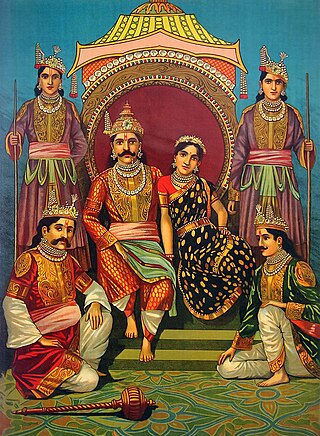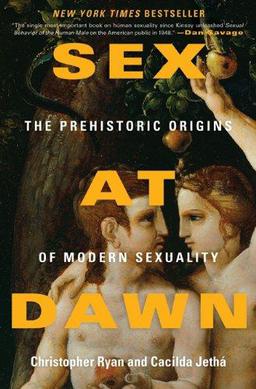Related Research Articles

Polyandry is a form of polygamy in which a woman takes two or more husbands at the same time. Polyandry is contrasted with polygyny, involving one male and two or more females. If a marriage involves a plural number of "husbands and wives" participants of each gender, then it can be called polygamy, group or conjoint marriage. In its broadest use, polyandry refers to sexual relations with multiple males within or without marriage.

A father is the male parent of a child. Besides the paternal bonds of a father to his children, the father may have a parental, legal, and social relationship with the child that carries with it certain rights and obligations. A biological father is the male genetic contributor to the creation of the infant, through sexual intercourse or sperm donation. A biological father may have legal obligations to a child not raised by him, such as an obligation of monetary support. An adoptive father is a man who has become the child's parent through the legal process of adoption. A putative father is a man whose biological relationship to a child is alleged but has not been established. A stepfather is a non-biological male parent married to a child's preexisting parent and may form a family unit but generally does not have the legal rights and responsibilities of a parent in relation to the child.

A parent is either the progenitor of a child or, in humans, it can refer to a caregiver or legal guardian, generally called an adoptive parent or step-parent. The gametes of a parent result in a child, a male through the sperm, and a female through the ovum. Parents who are progenitors are first-degree relatives and have 50% genetic meet. A female can also become a parent through surrogacy. Some parents may be adoptive parents, who nurture and raise an offspring, but are not related to the child. Orphans without adoptive parents can be raised by their grandparents or other family members.

Jealousy generally refers to the thoughts or feelings of insecurity, fear, and concern over a relative lack of possessions or safety.

Infidelity is a violation of a couple's emotional and/or sexual exclusivity that commonly results in feelings of anger, sexual jealousy, and rivalry.

A paternal bond is the human bond between a father and his child.

David Michael Buss is an American evolutionary psychologist at the University of Texas at Austin, researching human sex differences in mate selection. He is considered one of the founders of evolutionary psychology.

Parental investment, in evolutionary biology and evolutionary psychology, is any parental expenditure that benefits offspring. Parental investment may be performed by both males and females, females alone or males alone. Care can be provided at any stage of the offspring's life, from pre-natal to post-natal.

Sexual jealousy is a special form of jealousy in sexual relationships, based on suspected or imminent sexual infidelity. The concept is studied in the field of evolutionary psychology.

Sociology of the family is a subfield of the subject of sociology, in which researchers and academics study family structure as a social institution and unit of socialization from various sociological perspectives. It can be seen as an example of patterned social relations and group dynamics.
Human male sexuality encompasses a wide variety of feelings and behaviors. Men's feelings of attraction may be caused by various physical and social traits of their potential partner. Men's sexual behavior can be affected by many factors, including evolved predispositions, individual personality, upbringing, and culture. While most men are heterosexual, there are minorities of homosexual men and varying degrees of bisexual men.
Extra-pair copulation (EPC) is a mating behaviour in monogamous species. Monogamy is the practice of having only one sexual partner at any one time, forming a long-term bond and combining efforts to raise offspring together; mating outside this pairing is extra-pair copulation. Across the animal kingdom, extra-pair copulation is common in monogamous species, and only a very few pair-bonded species are thought to be exclusively sexually monogamous. EPC in the animal kingdom has mostly been studied in birds and mammals. Possible benefits of EPC can be investigated within non-human species, such as birds.
In genetics, a non-paternity event is the situation in which someone who is presumed to be an individual's father is not in fact the biological father. This presumption of NPE is a subset of a misattributed parentage experience (MPE) which may be on the part of the individual, the parents, or the attending midwife, physician or nurse. An NPE may result from sperm donation, undisclosed adoption, heteropaternal superfecundation, promiscuity, paternity fraud, or sexual assault, as well as medical mistakes, for example, mixups during procedures such as in vitro fertilization and artificial insemination. Where there is uncertainty, the most reliable technique for establishing paternity is genetic testing; however, there is still a risk of error due to the potential for gene mutations or scoring errors.
Monogamy is a relationship of two individuals in which they form an exclusive intimate partnership. Having only one partner at any one time, whether that be for life or whether that be serial monogamy, contrasts with various forms of non-monogamy. More generally, the term is used to describe the behavioral ecology and sexual selection of animal mating systems, referring to the state of having only one mate at any one given time. In a human cultural context, monogamy typically refers to the custom of two individuals, regardless of orientation, committing to a sexually exclusive relationship.

Sex at Dawn: The Prehistoric Origins of Modern Sexuality is a 2010 book about the evolution of human mating systems by Christopher Ryan and Cacilda Jethá. In opposition to what the authors see as the "standard narrative" of human sexual evolution, they contend that having multiple sexual partners was common and accepted in the environment of evolutionary adaptedness. The authors contend that mobile, self-contained groups of hunter-gatherers were the norm for humans before agriculture led to high population density. Before agriculture, according to the authors, sex was relatively promiscuous and paternity was not a concern. This dynamic is similar to the mating system of bonobos. According to the book, sexual interactions strengthened the bond of trust in the groups. Far from causing jealousy, social equilibrium and reciprocal obligation were strengthened by playful sexual interactions.
Due to not carrying the child, the male is suggested to experience paternal uncertainty.

In behavioral ecology, polyandry is a class of mating system where one female mates with several males in a breeding season. Polyandry is often compared to the polygyny system based on the cost and benefits incurred by members of each sex. Polygyny is where one male mates with several females in a breeding season . A common example of polyandrous mating can be found in the field cricket of the invertebrate order Orthoptera. Polyandrous behavior is also prominent in many other insect species, including the red flour beetle, the adzuki bean weevil, and the species of spider Stegodyphus lineatus. Polyandry also occurs in some primates such as marmosets, mammal groups, the marsupial genus' Antechinus and bandicoots, around 1% of all bird species, such as jacanas and dunnocks, insects such as honeybees, and fish such as pipefish.
Paper abortion, also known as a financial abortion, male abortion or a statutory abortion, is the proposed ability of the biological father, before the birth of the child, to opt out of any rights, privileges, and responsibilities toward the child, including financial support. By this means, before a child is born, a man would be able to absolve himself of both the privileges and demands of fatherhood.
Sexuality in South America varies by region and time period. Before the arrival of Europeans in South America, the different Indigenous people living there had multiple types of sexualities: there was not a single norm, but several practices that were part of a more diverse sexuality than in the West. Homosexual practices were common, and sexuality, far from being a taboo, was represented in art and everyday objects. The arrival of Europeans changed South American sexual practices and gender expressions, forcing them to adhere to the classical heteronormative model.
Few animals have a menopause: humans are joined by just four other species in which females live substantially longer than their ability to reproduce. The others are all cetaceans: beluga whales, narwhals, orcas and short-finned pilot whales. There are various theories on the origin and process of the evolution of menopause. These attempt to suggest evolutionary benefits to the human species stemming from the cessation of women's reproductive capability before the end of their natural lifespan. Explanations can be categorized as adaptive and non-adaptive:
References
- ↑ Bressan, P. (2002). "Why babies look like their daddies: Paternity uncertainty and the evolution of self-deception in evaluating family resemblance". Acta Ethologica. 4 (2): 113–118. doi:10.1007/s10211-001-0053-y. S2CID 40176844.
- ↑ Starkweather, Katie, "A Preliminary Survey of Lesser-Known Polyandrous Societies" (2009).Nebraska Anthropologist.Paper 50. http://digitalcommons.unl.edu/nebanthro/50
- 1 2 The Barí Partible Paternity Project: Preliminary Results. Stephen Beckerman, Roberto Lizarralde, Carol Ballew, Sissel Schroeder, Christina Fingelton, Angela Garrison, and Helen Smith. Current Anthropology, Vol. 39, No. 1 (February 1998), pp. 164–168
- ↑ Walker, R. S.; Flinn, M. V.; Hill, K. R. (2010). "Evolutionary history of partible paternity in lowland South America". Proceedings of the National Academy of Sciences. 107 (45): 19195–19200. Bibcode:2010PNAS..10719195W. doi: 10.1073/pnas.1002598107 . ISSN 0027-8424. PMC 2984172 . PMID 20974947.
- 1 2 Beckerman, S., Valentine, P., (eds) (2002) The Theory and Practice of Partible Paternity in South America, University Press of Florida
- ↑ Connor, Steve (January 24, 1999). "Amazon tribes believe a child can have more than one father" . The Independent . Archived from the original on 2022-05-25. Retrieved October 21, 2017.
- ↑ Pollock D (2002) Partible paternity and multiple paternity among the Kulina. Cultures of Multiple Fathers: Theory and Practice of Partible Paternity in Lowland South America, eds Beckerman S, Valentine P (University Press of Florida, Gainesville, FL), pp 42–61.
- ↑ Robert S. Walker, Mark V. Flinn, and Kim R. Hill. Evolutionary history of partible paternity in lowland South America .PNAS 2010 107 (45)
- ↑ Beckerman, Stephen and Paul Valentine 2002 Introduction. The concept of partible paternity among Native South Americans. In Cultures of Multiple Fathers: the theory and practice of partible paternity in Lowland South America. Beckerman, Stephen and Paul Valentine, eds, pp. 1–13. Gainesville, FL:. University Press of Florida
- ↑ . Chernela J (2002) Fathering in the Northwest Amazon of Brazil: Competition, monopoly, and partition. Cultures of Multiple Fathers: Theory and Practice of Partible Paternity in Lowland South America, eds Beckerman S, Valentine P (University Press of Florida, Gainesville, FL), pp 160–176.
- ↑ Milius, S. 1999. Who says only one sperm gets the prize? Science News, 155(5),71.
- ↑ Ellsworth, Ryan. (2011). The human that never evolved: A review of Christopher Ryan and Caclida Jethá, Sex at Dawn: How We Mate, Why We Stray, and What It Means for Modern Relationships.. Evolutionary psychology : an international journal of evolutionary approaches to psychology and behavior. 9. 325-35.
- ↑ Shapiro, Warren. Partible paternity and anthropological theory: the construction of an ethnographic fantasy. University Press of America, 2009, chapters 3–8
- ↑ Walker, Robert S., Mark V. Flinn, and Kim R. Hill. "Evolutionary history of partible paternity in lowland South America." Proceedings of the National Academy of Sciences 107, no. 45 (2010): 19195-19200.
- ↑ Poolua in Hawaii